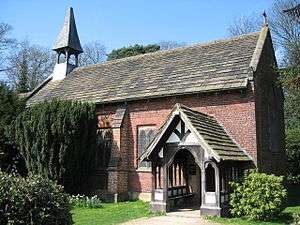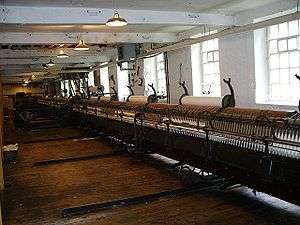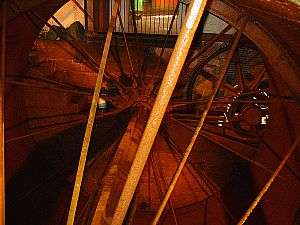Quarry Bank Mill
 | |
| Owner | Samuel Greg |
|---|---|
| Further ownership |
|
| Coordinates | 53°20′38″N 2°14′58″W / 53.34390°N 2.24950°WCoordinates: 53°20′38″N 2°14′58″W / 53.34390°N 2.24950°W |
| Construction | |
| Built | 1784 |
| Renovated |
|
| Floor count | 5 |
| Power | |
| Date | 1796,1810 |
| Engine maker | Boulton & Watt |
| Water Power | |
| Diameter / width of water wheel | 32 feet (9.8 m) / 21 feet (6.4 m) |
Quarry Bank Mill in Styal, Cheshire, England, is one of the best preserved textile mills of the Industrial Revolution and is now a museum of the cotton industry. It is recorded in the National Heritage List for England as a designated Grade II* listed building,[1] and inspired the 2013 television series The Mill.[2]
Location
Quarry Bank Mill is on the outskirts of Styal in Cheshire, abutting and to the south of Manchester Airport. The mill is on the bank of the River Bollin which provided water to power the waterwheels. It was connected by road to the Bridgewater Canal for transporting raw cotton from the port of Liverpool.[3] The site consisted of three farms or folds.
History
Samuel Greg leased land at Quarrell Hole on Pownall Fee from Lord Stamford, who imposed a condition that 'none of the surrounding trees should be pruned, felled or lopped´; maintaining the woodland character of the area. The factory was built in 1784 by Greg[4] to spin cotton. When Greg retired in 1832 it was the largest such business in the United Kingdom. The water-powered Georgian mill still produces cotton calico. The Gregs were careful and pragmatic, paternalistic millowners, and the mill was expanded and changed throughout its history. When Greg's son, Robert Hyde Greg, took over the business, he introduced weaving. Samuel Greg died in 1834.
The Mill was attacked during the Plug Plot riots on 10 August 1842.[5]
The mill's iron water wheel, the fourth to be installed, was designed by Thomas Hewes and built between 1816 and 1820. Overhead shafts above the machines were attached to the water wheel by a belt. When the wheel turned, the motion moved the belt and powered the machinery. A beam engine and a horizontal steam engine were subsequently installed to supplement the power. The Hewes wheel broke in 1904 but the River Bollin continued to power the mill through two water turbines. The mill owners bought a Boulton and Watt steam engine in 1810 and a few years later purchased another because the river's water level was low in summer and could interrupt production of cloth during some years. Steam engines could produce power all year round. Today the mill houses the most powerful working waterwheel in Europe, an iron wheel moved from Glasshouses Mill at Pateley Bridge designed by Sir William Fairbairn who had been Hewes' apprentice.
The estate surrounding the mill was developed and Greg converted farm buildings in Styal to house workers. As the mill increased in size, housing was constructed for the workers.[6] A chapel and a school were built by the Gregs who moved into Quarry Bank House next to the mill.
The estate and mill were donated to the National Trust in 1939 by Alexander Carlton Greg and are open to the public. The mill continued in production until 1959. In 2006 the National Trust acquired Quarry Bank House and its gardens and, in 2010, the gardener's house and the upper gardens.[7] In 2013 the mill received 130,000 visitors.[8] In 2013, the trust launched an appeal to raise £1.4 million to restore a worker's cottage, a shop and the Greg's glasshouses and digitise records relating to Gregs and the mill workers.[8]
Architecture
Quarry Bank is an example of an early, rural, cotton-spinning mill that was initially dependent on water power. The first mill was built by Samuel Greg and John Massey in 1784. Its design was functional and unadorned, growing out of the pragmatism of the men who felt no need to make a bold architectural statement.[9] It was a four-storey mill measuring 8.5 metres (28 ft) by 27.5 metres (90 ft), with an attached staircase, counting house and warehouse. It was designed to use water frames which had just come out of patent, and the increased supply of cotton caused by the cessation of the American War of Independence. The water wheel was at the north end of the mill.
The mill was extended in 1796 when it was doubled in length and a fifth floor added. A second wheel was built at the southern end. The mill was extended between 1817 and 1820 and a mansard-roofed wing extended part of the 1796 building forward beneath which the wheel was installed. The new building kept the 1784 detailing with respect to line and windows.[10] The 1784 mill ran 2425 spindles, after 1805 with the new wheel it ran 3452 spindles.[11]
Weaving sheds added in 1836 and 1838 were of two storeys and housed 305 looms.[12] Before the 1830s, spinning mills produced cotton, that was put-out to hand-loom weavers who worked in their own homes or small loom shops, like the one Greg owned at Eyam.[13] Hand-loom weaving continued in parallel to power loom weaving throughout the 19th century. Around 1830 the power loom became sufficiently viable for independent weaving sheds to be set up, and for larger owners to add weaving sheds to their spinning mills. A weaving shed needed the correct light and humidity and a floor that was stable enough to withstand the vibration caused by the picking of many looms. Quarry Bank Mill is of national significance in that it used two-storey side-lit buildings rather the a single storey sheds with a saw-tooth roof.[14] The first two-storey shed at Quarry Bank was 33 metres (108 ft) by 6.5 metres (21 ft). The 1838 building was 30 metres (98 ft) by 10 metres (33 ft) to which a storey was added in 1842 for warping and beaming. In the Gregs pragmatic way, looms were purchased gradually.[15]
Water power
The first wheel was a wooden overshot wheel taking water by means of a long leat from upstream on the River Bollin. The second wheel built by Peter Ewart in 1801 was wooden. To increase power he dammed the Bollin and took water into the mill directly, the tailrace leaving the river below the dam. The third wheel of 1807 was a replacement for one of the wooden wheels.[16] It is believed it was a suspension wheel, 8 metres (26 ft) in diameter made from iron to the design of Thomas Hewes.[11]
The fourth wheel, the Great Wheel was also designed by Hewes. The challenge was to increase the head of water acting on the wheel while using the same volume of water. It was achieved by sinking the wheel pit to below the level of the river and taking the tail race through a tunnel a kilometre downstream to rejoin the Bollin at Giant's Castle. This gave a head of 32 feet (9.8 m) acting on the 32 feet (9.8 m) diameter suspension wheel- which is 21 feet (6.4 m) wide. The Great Wheel operated from 1818 to 1871 when the mill pool had silted up, and then to 1904.[17]
In 1905 two water turbines built by Gilbert Gilkes and Company were installed to replace the Great Wheel. They used the same head and tail race and operated until 1959.[18] When the mill was restored in 1983, a 25 feet (7.6 m) diameter waterwheel of similar design to that of Hewes by his pupil Sir William Fairbairn, was moved from Glasshouses Mill in Pateley Bridge and installed to provide power to work the machinery.
Steam power
Water flow from the Bollin was unreliable so an auxiliary steam engine was procured in 1810.[16] It was a 10 hp beam engine from Boulton and Watt. In 1836 with the arrival of power looms a second 20 hp Boulton and Watt beam engine was acquired. The first horizontal condensing engine was acquired in 1871. A new engine house was built. In 1906 the 1871 engine was replaced by a second-hand 60 hp engine.[19] The engines no longer exist and the museum has purchased a similar steam engine to display.
Apprentice system

Quarry Bank Mill employed child apprentices, a system that continued until 1847. The last child to be indentured started work in 1841. The first children apprentices lived in lodgings in the neighbourhood then in 1790 Greg built the Apprentice House near the factory.[20] Greg believed he could get the best out of his workers by treating them fairly. He hired a superintendent to attend to their care and morals and members of the Greg family and external tutors gave them lessons.[20] Greg employed Peter Holland, father of the Royal Physician Sir Henry Holland, 1st Baronet and uncle of Elizabeth Gaskell, as mill doctor. Holland was responsible for the health of the children and other workers, and was the first doctor to be employed in such a capacity. The apprentices were children from workhouses. Initially, they were brought from Hackney and Chelsea but by 1834 they came mostly from neighbouring parishes or Liverpool poorhouses.[20] They worked long days with schoolwork and gardening after their shift at the mill. The work was sometimes dangerous, with fingers sometimes being severed by the machines.[21] Children were willing to work in the mill because life at a workhouse was even worse.[22]
Mill community
The sparse accommodation that existed when the Gregs built the mill was soon exhausted and Greg built plain cottages which were rented to his workers. Each house had a parlour, kitchen and two bedrooms, an outside privy and a small garden. Rent was deducted from the workers' wages.[20] Greg, like Robert Owen, who built New Lanark attempted to bring the structured order of a country village to his new industrial centres. He built Oak School to educate the children and the Norcliffe Chapel where the villagers worshipped and held a Sunday school.[23]
- The village of Styal
 Workers cottages
Workers cottages Workers cottages
Workers cottages
Slave trade
The Gregs were involved in the triangular trade. Samuel Greg's brother-in-law, Thomas Hodgson, owned a slave ship, his father Thomas Greg and his brother John Greg part owned sugar plantations in the Caribbean on the island of Dominica. The best documented is Hillsborough Estate, Domenica which had 71 male and 68 female slaves. In January 1814, 20 slaves absconded, and were recaptured and punished with 100 lashes for the males and 50 for the females. The slaves believed that one of their number had died in the plantation hospital and they believed he had been poisoned.[24][25]
Gallery
- Working machines
 A working Mule spinning machine at Quarry Bank Mill.
A working Mule spinning machine at Quarry Bank Mill. A movie of the working Mule spinning machine at Quarry Bank Mill.
A movie of the working Mule spinning machine at Quarry Bank Mill.
.jpg) The new wheel
The new wheel
Events/media
In 2013, Channel 4 produced a docudrama, The Mill, inspired by the history of Quarry Bank Mill.
See also
- Grade II* listed buildings in Cheshire East
- Listed buildings in Wilmslow
- Factory Acts
- List of textile mills in Cheshire
References
- Notes
- ↑ Historic England, "Quarry Bank Mill (1237687)", National Heritage List for England, retrieved 11 September 2013
- ↑ "Clock-in". The Mill. Series 1. Episode 1. 2013-07-28. Channel 4. Retrieved 2013-08-03.
- ↑ Westall 1994, Illustration 59.
- ↑ "Quarry Bank Mill history". Retrieved 2007-09-25.
- ↑ 'The Disturbances in the Manufacturing Districts' Illustrated London News, August 20, 1842, p.233
- ↑ "Styal Village". Retrieved 2007-09-25.
- ↑ National Trust Magazine, Spring 2013
- 1 2 BBC News: Project to restore Quarry Bank Mill in Cheshire (accessed 12 February 2013)
- ↑ Calladine & Fricker 1996, p. 161.
- ↑ Calladine & Fricker 1996.
- 1 2 Bourne 2007, p. 12.
- ↑ Calladine & Fricker 1996, pp. 123-127, 134.
- ↑ Calladine & Fricker 1996, p. 38.
- ↑ Calladine & Fricker 1996, p. 123.
- ↑ Calladine & Fricker 1996, p. 124.
- 1 2 Calladine & Fricker 1996, p. 61.
- ↑ Bourne 2007, pp. 13,14.
- ↑ Bourne 2007, p. 13.
- ↑ Bourne 2007, pp. 14,15.
- 1 2 3 4 Calladine & Fricker 2007, p. 155.
- ↑ Bourne 2007, p. 27.
- ↑ Examination of Thomas Priestly, 02-08-1806, Manchester Central Reference Library, C5/8/9/5 (1806.
- ↑ Calladine & Fricker 2007, pp. 155-7.
- ↑ Bourne 2007, p. 19.
- ↑ › Domenica Estates Janus Repositories, University of Cambridge
- Bibliography
- Calladine, Anthony; Fricker, Jean (1993). East Cheshire Textile Mills. London: Royal Commission on Historical Monuments of England. ISBN 1-873592-13-2.
- Bourne, Matt (2007). Quarry Bank Mill and Styal Estate. The National Trust. ISBN 978-1-84359-258-7.
- Owens, Jessica (2010). Quarry Bank Mill and Styal Estate. GCSE Resources (14-05-2010 ed.). National Trust.
- Rose, Mary (1986). The Gregs of Quarry Bank Mill: the rise and decline of a family firm, 1750-1914. Cambridge University Press. ISBN 978-0521323826.
- Westall, Roy (1994). Wilmslow and Alderley Edge ; Quarry Bank Mill & Manchester Airport. Chichester, West Sussex: Phillimore & Co. ISBN 0-85033-867-0.
External links
| Wikimedia Commons has media related to Quarry Bank Mill. |
- Quarry Bank Mill and Styal Estate information at the National Trust
- National Trust: Collection of primary source documents relating to the Gregs and Quarry Bank Mill
- The Mill Channel 4
- The sound of Quarry Bank Mill on Sound Tourism site
- Information and Photos

